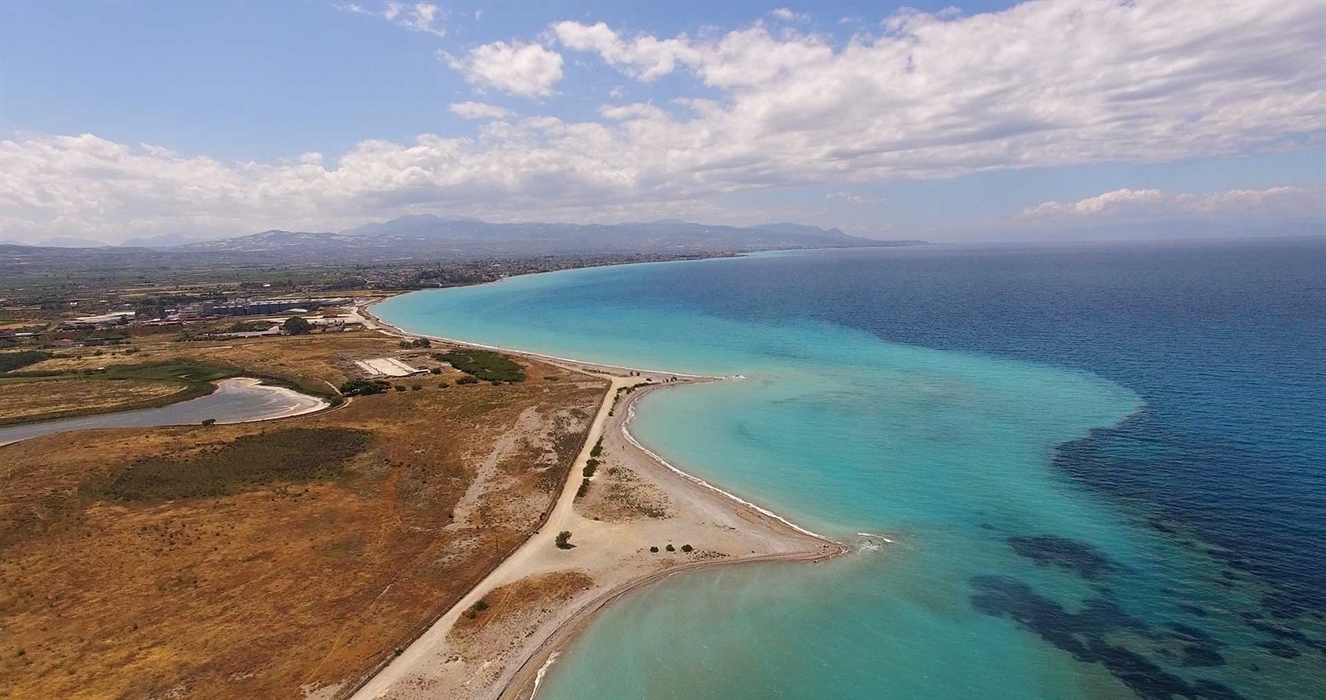The ancient port of Lechaion
The west seaport of Corinth in the Saronic Gulf was one of the most important ports in the Antiquity - a contributing factor was its proximity to the city and its innovative facilities. At the naval base of Lechaion, they built the famous Corinthian triremes.
The west seaport of Corinth in the Saronic Gulf was one of the most important ports in the Antiquity - a contributing factor was its proximity to the city. The other port, in the Corinthian Gulf, was Kenchreai. The ports were named after Kenchrias and Leches, the twin sons of Poseidon and Peirene, daughter of river god Achelous.
The two main construction phases of the port of Lechaion date back to the Archaic (6th century BC) and the Roman era (1st century BC). It was still in use in the Early Christian period, as indicated by the great in size Early Christian basilica, excavated by the coast.
Civil engineering works began in the early Archaic period, in order to serve the strategically important purpose of creating Corinthian colonies - the port had a west orientation, in any case.
Corinthians increased the capacity and enhanced security with works considered state of the art at the time. They were imitated by Carthaginians, and later by Romans, who did similar works on other ports.
The port of Lechaion was artificial, separated into the commercial section and the naval base. Like the city of Corinth, it was protected by the Hexamilion wall , and people walked on the cobblestone street, called Lechaion Street. Along the port, stone piers were built, along with docks, breakwaters, ramps, warehouses, and other facilities, for the traffic and storage of merchandise, which was transported to the Corinthian colonies.
At the naval base of Lechaion, there were many shipbuilding facilities. This was the place where triremes were built, not only for Corinth, but also for other city-states. Thus, the first military naval industry was established. Its high value is proved by the fact that in 334 BC, Corinth contributed 160 fully equipped triremes to Alexander the Great’s fleet.
The Early Christian Basilica of Lechaion (Leonidis)
It is the most important Early Christian monument in the Peloponnese and the longest basilica in Greece (220 m). It covers 11,000 square meters and it is located on the west side of the ancient port of Lechaion. It is dedicated to the Bishop of Athens Leonidis and seven women who became martyrs alongside him around the mid-3rd century AD. It has three aisles, with a five-aisled transept and a dome, a narthex, a double atrium, a baptistery and multiple annexes. The floors are covered with white marble tiles. Exquisite was the sculptural decoration. In the surrounding space, architectural members are scattered, whereas others are hosted in the Archaeological Museum of Corinth.
The foundation of the nave was laid under the reign of Emperor Marcianus (450-457 AD), or during the early years of reign of his successor, Leo I (457-474 AD). It was completed under Justin I (518-527 AD). Unfortunately, in 551/552 AD, a terrible earthquake in the area destroyed utterly the magnificent monument, which excavations brought back to light in the 1950s and 1960s.
See more on the website of the Archaeological Museum of Ancient Corinth.
Did you know that
The underwater archaeological research at the port of Lechaion is conducted as part of Lechaion Harbour Project, initiated in 2013. It is a collaboration among the Ephorate of Underwater Antiquities, SAXO-Institute, the University of Copenhagen and the Danish Institute in Athens. Thousands of square meters of the sunken harbour facilities have been discovered and identified, and there are very significant findings, such as pier foundations, building remainders, etc. Watch videos.
The ancient port of Lechaion is located by the original Greek National Road, leading to Lechaion settlement from Corinth.
Location
Find the destination on the interactive map below.
Categories
Weather
Σχετικό περιεχόμενο χρηστών (UGC)
Ενημερωθείτε για ενδιαφέροντα θέματα γύρω από τον προορισμό μέσα από το περιεχόμενο των χρηστών μας
Discover 7 hidden gems of the Peloponnese
Many of you may have already visited some of the most renowned attractions…
TOP 10 archaeological museums in the Peloponnese
Olympia, Mycenae, Epidaurus, Diros Cave, Ancient Corinth, Messene and…
TOP 10 Castles in the Peloponnese
Castles galore! Mystras, Monemvasia, Palamidi, Methoni, Koroni,…
Newsletters
- About us
- FAQ's
- Map
- Tourism information centers
- Disclaimer
- Sitemap
- Our brand
- Media roum
- Adding your bussiness
- Corporate
- MICE

Peloponnese. Greece beyond the obvious





Design and creation from Cosmote
Marinas and Moorings
Diving centers
Get inspired
- Media gallery
- Blog
- The Peloponnese in the media
- Your feedback
- Users' general content
- Users' local products
- Users' events content
- Ask a local
More
- Accommodation
- Travel agencies
- Restaurants
- Services
- Destinations Map
- Weather
- Public transport
- Events
- Frequently asked questions
- Useful phones
- B2B
- Destination Data
- Contact

